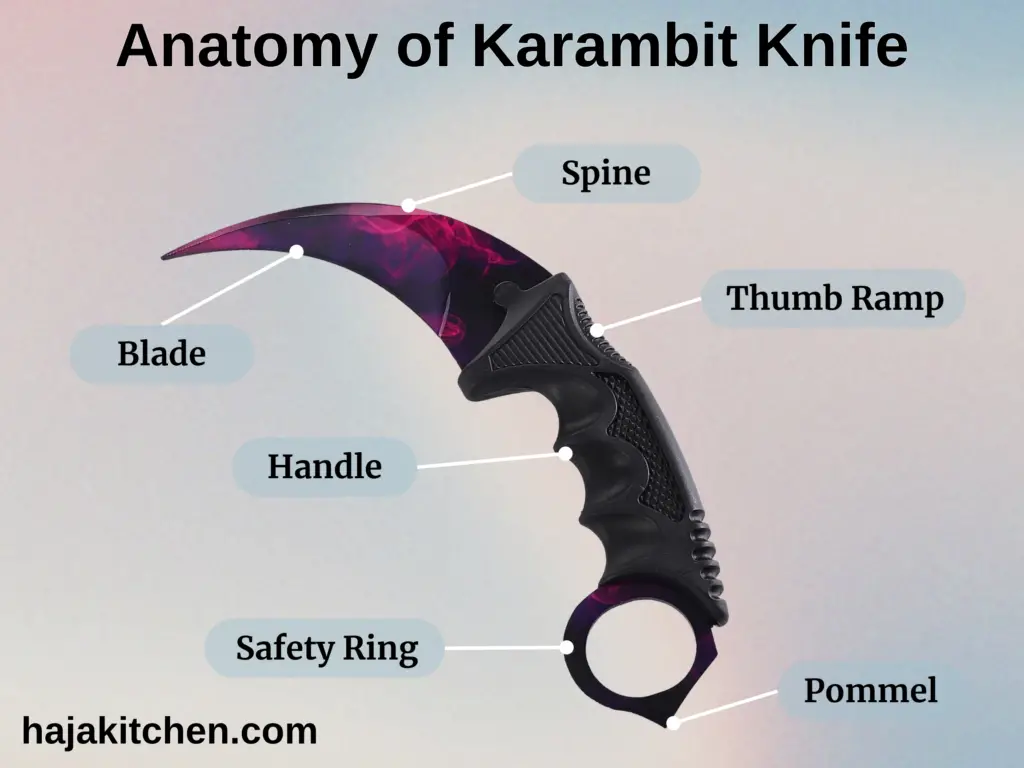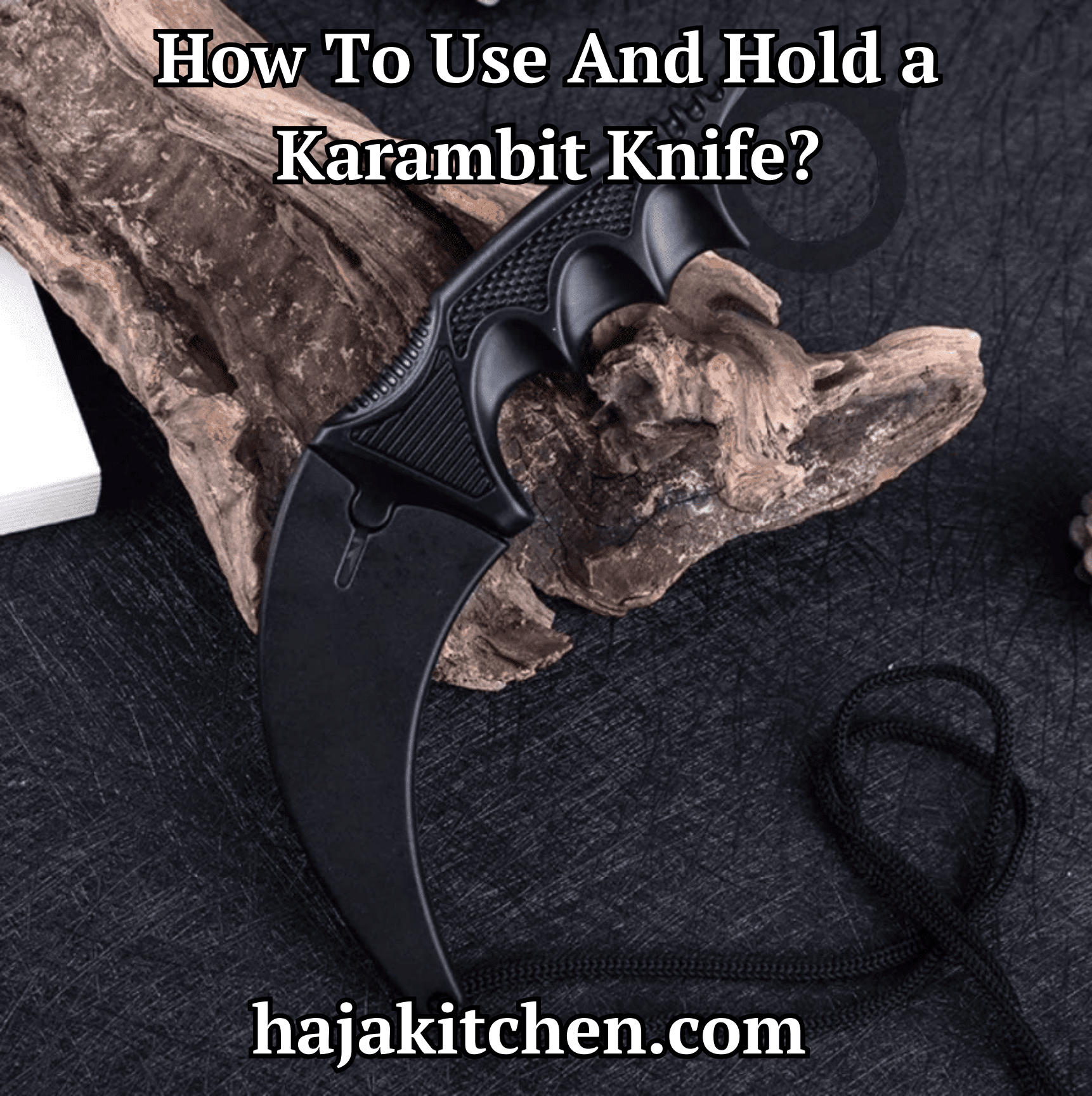If you’ve ever been intrigued by the unique design and functionality of a karambit knife, you’re not alone. This versatile tool, with its curved blade and ergonomic handle, has gained popularity among martial artists, self-defense enthusiasts, and outdoor adventurers. But before you can fully harness the power of a karambit knife, it’s crucial to understand the proper techniques for using and holding it. In our article – how to use and hold a karambit knife, we will walk you through the essential steps to become proficient in using and holding a karambit knife, ensuring both safety and effectiveness.
Understanding the Karambit Knife
Before delving into the techniques, it’s important to familiarize yourself with the anatomy and purpose of a karambit knife.
Anatomy of Karambit Knife

- Blade
The blade of a karambit knife is characterized by its distinctive curved shape, resembling a tiger’s claw. It typically features a single-edge design, with the inner curve serving as the primary cutting edge. The blade is usually made of high-quality stainless steel or other durable materials to ensure sharpness, strength, and corrosion resistance.
Tip: The tip of the karambit knife is often pointed and curved, allowing for precise piercing and controlled slashing movements. It enhances the knife’s effectiveness in self-defense and tactical applications, making it suitable for various cutting techniques.
- Spine
The spine refers to the back or non-cutting edge of the blade. It runs parallel to the cutting edge and provides structural support and stability to the knife. The spine can vary in thickness, depending on the specific design and intended use of the karambit knife. - Handle
The handle of a karambit knife is ergonomically designed to provide a secure and comfortable grip during use. It is typically curved and contoured to fit the natural shape of the hand, allowing for better control and maneuverability. The handle may feature textured or grooved patterns to enhance grip even in wet or slippery conditions. - Safety Ring
One distinctive feature of a karambit knife is the safety ring or finger ring located at the end of the handle. This ring serves multiple purposes. It provides a secure point of attachment for the index finger, preventing accidental slippage during use. Additionally, the safety ring allows for quick deployment and retention of the knife, enabling seamless transitions between various gripping techniques. - Thumb Ramp
Some karambit knives incorporate a thumb ramp, a raised area on the spine near the handle. The thumb ramp offers added control and stability when applying pressure or performing intricate cutting maneuvers. It assists in maintaining a firm grip on the knife during demanding tasks. - Pommel
The pommel refers to the end of the handle opposite the blade. It can be solid or hollow, depending on the knife’s design. The pommel serves as a counterbalance to the blade and can be used for striking or as a control point during specific techniques.
Purpose of a Karambit Knife
So, let’s discuss what are karambits used for? The purpose of a karambit knife is multi-faceted. Originally designed as a utility tool for farming and agricultural tasks in Southeast Asia, it has gained popularity as a self-defense and combat weapon due to its ergonomic design and versatile blade shape. The curved blade and pointed tip allow for quick and efficient cuts, slashes, and hooks, making it effective for personal protection, martial arts, and tactical applications. Additionally, the karambit knife’s compact size and maneuverability make it suitable for everyday utility tasks like opening packages, cutting ropes, or performing general cutting duties.
It’s important to note that the usage of a karambit knife requires proper training, skill, and understanding of local laws and regulations. Always exercise caution and use the knife responsibly and within legal boundaries.
Mastering the Grip: Techniques for Optimal Control
How to use a karambit? To utilize a karambit knife effectively, mastering the proper grip is paramount. There are different gripping techniques, each serving specific purposes and providing enhanced control over the knife. Let’s explore two commonly used grips:
Standard Grip
This grip involves firmly holding the handle, positioning the index finger through the safety ring, and placing the thumb on the back of the handle. The standard grip offers stability, control, and versatility in various cutting and slashing movements.

- Hold the karambit with the handle firmly in your hand.
- Position your pinky finger through the safety ring.
- Place your thumb on the back of the handle, providing stability and control.
- Ensure a secure grip without restricting the movement of the blade.
Reverse Grip
With the reverse grip, the handle faces downward, and the pinky finger goes through the safety ring, while the thumb rests on the side of the handle. This grip is advantageous for close-quarter combat, allowing for efficient slashing and hooking motions.

- Hold the karambit with the handle facing downward.
- Position your index finger through the safety ring.
- Rest your thumb on the side of the handle, providing support and control.
- This grip offers versatility in close-quarter combat scenarios and allows for efficient slashing and hooking motions.
Effective Techniques for Using a Karambit Knife

Now that you’ve established a solid grip, it’s time to explore some fundamental techniques for using a karambit knife. These techniques will enable you to maximize the knife’s potential and ensure precise and controlled movements:
Slashing and Hooking
Capitalize on the curved blade of the karambit by delivering slashing and hooking motions. Practice controlled movements, targeting vital areas while maintaining a balance between force and precision. Remember to incorporate proper body positioning and footwork for optimal stability and power generation.
- Utilize the curved blade of the karambit to deliver slashing and hooking motions.
- Practice controlled and precise movements, targeting vital areas while minimizing unnecessary force.
- Remember to maintain proper body positioning and footwork for optimal balance and stability.
Retracting Strikes
One of the key advantages of a karambit use knife is its ability to retract strikes effectively. After executing a strike, swiftly retract the blade, maintaining readiness for subsequent movements or defensive actions. This technique ensures fluidity and quick recovery between strikes.
- One of the unique features of the karambit is its ability to retract strikes effectively.
- After making a strike, swiftly retract the blade, preparing for the next movement or defensive action.
- This technique ensures efficiency and quick recovery between strikes.
Flow Drills and Sparring
To further enhance your skills with a karambit knife, engage in flow drills and controlled sparring sessions. These training exercises simulate real-life scenarios, allowing you to develop muscle memory, reflexes, and tactical awareness. Always prioritize safety during practice, utilizing appropriate protective gear and training under the guidance of a qualified instructor.
- To further enhance your skills with the karambit, engage in flow drills and controlled sparring sessions.
- These training exercises simulate real-life situations and help develop muscle memory and reflexes.
- Always prioritize safety during practice sessions, using appropriate protective gear and training with a qualified instructor.
For better understanding how it works, you can see on the video below:
Conclusion
By mastering the art of using and holding a karambit knife, you unlock a world of versatility and practicality. With the right techniques, grip, and understanding of this exceptional blade, you can confidently tackle various tasks, whether it’s in the realm of self-defense, outdoor adventures, or simply appreciating the craftsmanship. Remember, practice makes perfect, so embark on this exciting journey and explore the boundless possibilities that come with wielding a karambit knife. Hope, now you know how karambit use.
FaQ
What are some common mistakes to avoid when using a karambit knife?
• Incorrect grip: Failing to hold the knife in the appropriate grip can lead to decreased control and potential accidents. Ensure you practice and maintain a proper grip.
• Lack of training: Using a karambit knife without proper training and understanding of its techniques can result in ineffective use and increased risk of injury.
• Overconfidence: Overestimating your abilities or relying solely on the knife without considering other self-defense strategies can be a mistake. It’s important to have a well-rounded approach to personal safety.
• Reckless use: Using excessive force or making wild swings can lead to unintended consequences. Exercise caution and precision when utilizing a karambit knife.
Are there any specific safety considerations when using a karambit knife?
• Training: It is essential to undergo proper training and practice to ensure proficiency and minimize the risk of accidents or self-inflicted injuries.
• Awareness: Always be aware of your surroundings and potential bystanders to avoid causing harm unintentionally.
• Care and maintenance: Keep the knife clean and sharp to ensure optimal performance and reduce the chances of slippage or mishandling.
• Legal restrictions: Understand and comply with local laws regarding the carrying and use of karambit knives, as they may be classified as restricted or prohibited in some jurisdictions.
What are the advantages of using a karambit knife over other types of knives?
• Versatility: The curved blade and unique design of the karambit knife allow for various cutting techniques, making it versatile in self-defense situations.
• Retention: The finger ring on the handle provides better retention and grip, minimizing the risk of the knife being disarmed during a confrontation.
• Intimidation factor: The distinct appearance of a karambit knife can act as a deterrent, potentially discouraging an attacker from further engagement.
• Ergonomics: The design of the karambit knife fits comfortably in the hand, allowing for enhanced control and precision during use.
• Close-quarter effectiveness: The curved blade and ergonomic grip make the karambit knife particularly effective in close-quarters combat or self-defense scenarios.
Can the techniques for using a karambit knife be applied in real-life self-defense situations?
Yes, the techniques for using a karambit knife can be applied in real-life self-defense situations. However, it is crucial to receive proper training and practice regularly to develop the necessary skills and reflexes. Additionally, understanding legal implications and employing good judgment are essential when using any self-defense tool. Combining karambit knife techniques with situational awareness and de-escalation strategies can increase the effectiveness of self-defense in real-life scenarios.


